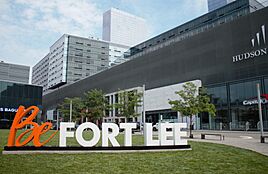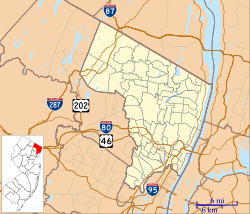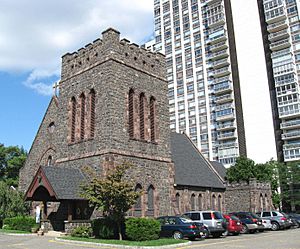Fort Lee, New Jersey facts for kids
Quick facts for kids
Fort Lee, New Jersey
|
||
|---|---|---|
|
Borough
|
||
|
Fort Lee Town Center
Main Street
Fort Lee Historic Park
The Modern
Constitution Park
|
||
|
||
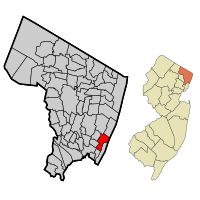
Location of Fort Lee in Bergen County highlighted in red (left). Inset map: Location of Bergen County in New Jersey highlighted in orange (right).
|
||
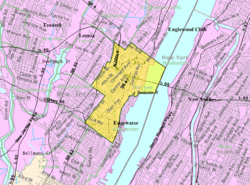
Census Bureau map of Fort Lee, New Jersey
<mapframe text="Interactive map of Fort Lee, New Jersey" zoom="8" width="250" height="250"> { "type": "ExternalData", "service": "geoshape", "ids": "Q1013261" } </mapframe> |
||
| Country | ||
| State | ||
| County | Bergen | |
| Incorporated | March 29, 1904 | |
| Named for | Fort Lee / General Charles Lee | |
| Government | ||
| • Type | Borough | |
| • Body | Borough Council | |
| Area | ||
| • Total | 2.86 sq mi (7.41 km2) | |
| • Land | 2.52 sq mi (6.52 km2) | |
| • Water | 0.34 sq mi (0.89 km2) 12.33% | |
| Area rank | 344th of 565 in state 30th of 70 in county |
|
| Elevation | 289 ft (88 m) | |
| Population
(2020)
|
||
| • Total | 40,191 | |
| • Estimate
(2023)
|
39,700 | |
| • Rank | 59th of 565 in state 3rd of 70 in county |
|
| • Density | 15,961.5/sq mi (6,162.8/km2) | |
| • Density rank | 16th of 565 in state 4th of 70 in county |
|
| Time zone | UTC−05:00 (Eastern (EST)) | |
| • Summer (DST) | UTC−04:00 (Eastern (EDT)) | |
| ZIP Code |
07024
|
|
| Area code(s) | 201 | |
| FIPS code | 3400324420 | |
| GNIS feature ID | 0885223 | |
Fort Lee is a town located on the eastern edge of Bergen County, in the state of New Jersey. It sits right along the Hudson River on top of a tall cliff called The Palisades.
In 2020, about 40,191 people lived in Fort Lee. This was a good increase from 2010. Fort Lee is known for having one of the largest and fastest-growing Korean communities outside of Korea.
Fort Lee gets its name from a military camp used during the American Revolutionary War. It's also famous for being where the American film industry first started in the early 1900s. In 1931, the George Washington Bridge was built here. This huge bridge crosses the Hudson River and connects Fort Lee to Manhattan in New York City. Since the 1960s, Fort Lee has grown a lot with many tall apartment buildings.
Contents
Exploring Fort Lee's Location
Fort Lee covers about 2.88 square miles (7.48 square kilometers). Most of this area is land, with a smaller part being water.
The town is located on top of the Hudson Palisades cliffs. It's on a peninsula between the Hackensack River and the Hudson River. The area near the George Washington Bridge Plaza is a busy spot where many roads meet.
Fort Lee shares borders with several other towns. These include Cliffside Park, Edgewater, Englewood, Englewood Cliffs, Leonia, Palisades Park, and Ridgefield. It's also very close to the Washington Heights area of Upper Manhattan. Because it's so close to New York City and has a diverse feel, some people call Fort Lee "New York City's Sixth Borough."
A Look Back at Fort Lee's History
Fort Lee's Early Days
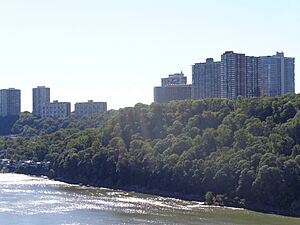
Fort Lee is named after General Charles Lee. This was after George Washington and his soldiers set up camp at Mount Constitution. They were defending New York City from this spot. During Washington's retreat in November 1776, Thomas Paine wrote his famous pamphlet, The American Crisis. It started with the well-known line, "These are the times that try men's souls." You can learn more about these events at Monument Park and Fort Lee Historic Park.
Fort Lee officially became a borough on March 29, 1904. It was formed from parts of Ridgefield Township. The Fort Lee Police Department was created in August 1904.
Birthplace of American Movies
The history of movies in the United States actually began on the East Coast. For a while, Fort Lee was the movie capital of America! This industry started in the late 1800s with Thomas Edison's "Black Maria" studio in West Orange, New Jersey. New Jersey was a good place for studios because land was cheaper than in New York City.
Filmmaking started to attract a lot of money and creative people. In 1907, the Kalem Company began filming in Fort Lee. Other filmmakers quickly followed. In 1909, the Champion Film Company, which later became part of Universal Studios, built the first movie studio in Fort Lee. Many other film companies, like Peerless Studios and Fox Film Corporation, also made movies here in the 1910s and 1920s. Famous actors like Mary Pickford started their careers at Biograph Studios in Fort Lee.
For almost 20 years, Fort Lee became very successful because of the movie industry. However, around the 1930s, most filmmaking moved to the West Coast, especially to Hollywood. One reason was California's better weather and lower costs. Also, Thomas Edison owned many patents for making movies. Filmmakers on the East Coast who didn't want to pay Edison often faced lawsuits. But on the West Coast, they could work more freely.
Even today, television and film are important industries in New Jersey. The Fort Lee Film Commission works to celebrate the town's movie history and attract new film and TV productions.
The Story of Subliminal Messages
In 1957, a market researcher named James Vicary claimed something interesting happened in Fort Lee. He said that flashing very quick messages on a movie screen made people buy more food and drinks. Vicary called this "subliminal advertising." He claimed that during the movie Picnic, he flashed the words "Drink Coca-Cola" and "Hungry? Eat popcorn" for a tiny fraction of a second. He said that popcorn sales went up by 57.8% and Coke sales by 18.1%.
However, in 1962, Vicary admitted that he had lied about the experiment and made up the results. It was just a marketing trick. Other tests showed no increase in sales.
People and Culture in Fort Lee
Around the year 2000, many Korean people moved to Fort Lee. This has turned much of the town into a large Koreatown. You can see many traditional Korean stores and restaurants there. Signs in the Korean alphabet (hangul) are as common as English signs in some areas. This Koreatown is different from the one in the nearby town of Palisades Park.
The number of Korean Americans in Bergen County is the highest of any county in the United States. In 2010, Fort Lee had about 8,318 Korean residents, making up 23.5% of its population. These Korean communities in Bergen County, along with those in New York City, form the second largest group of ethnic Koreans outside of Korea.
In 2011, about 2,500 Japanese-Americans lived in Edgewater and Fort Lee. This was the largest group of Japanese-Americans in New Jersey.
| Historical population | |||
|---|---|---|---|
| Census | Pop. | %± | |
| 1880 | 1,424 | — | |
| 1890 | 1,253 | −12.0% | |
| 1900 | 2,612 | 108.5% | |
| 1910 | 4,472 | 71.2% | |
| 1920 | 5,761 | 28.8% | |
| 1930 | 8,759 | 52.0% | |
| 1940 | 9,468 | 8.1% | |
| 1950 | 11,648 | 23.0% | |
| 1960 | 21,815 | 87.3% | |
| 1970 | 30,631 | 40.4% | |
| 1980 | 32,449 | 5.9% | |
| 1990 | 31,997 | −1.4% | |
| 2000 | 35,461 | 10.8% | |
| 2010 | 35,345 | −0.3% | |
| 2020 | 40,191 | 13.7% | |
| 2023 (est.) | 39,700 | 12.3% | |
| Population sources: 1910–1920 1910 1910–1930 1900–2020 2000 2010 2020 |
|||
Economy and Businesses
Some companies based in Fort Lee include WINIA Electronics America, the American Bank Note Company, and Cross River Bank.
Arts and Entertainment
The Barrymore Film Center is a large building that cost $16 million to build. It opened in October 2022 and has a movie theater, a performing arts center, and a film museum.
Since 2007, the Hudson Shakespeare Company has performed their "Shakespeare Tuesdays" shows in Fort Lee. They regularly perform at Monument Park during the summer.
Since the mid-1980s, Fort Lee's Koreatown has become a popular place for Korean food. Many people say the Korean food here is even better than in Koreatown, Manhattan. You can find all sorts of Korean dishes, including Korean Chinese cuisine and drinks like misugaru. Korean cafés are also a big part of the culture. They are places to enjoy coffee, bingsu (shaved ice), pastries, and gather with friends.
Learning in Fort Lee: Schools and Education
Public Schools
The Fort Lee School District serves students from pre-kindergarten all the way through twelfth grade. In the 2021–22 school year, the district had about 4,074 students across six schools. This means there were about 12.3 students for every teacher.
The schools in the district are:
- School 1 (grades K-4)
- School 2 (grades PreK-4)
- School 3 (grades K-4)
- School 4 (grades K-4)
- Lewis F. Cole Intermediate School / Lewis F. Cole Middle School (grades 5-8)
- Fort Lee High School (grades 9-12)
In 2010–11, School #3 received the National Blue Ribbon School Award of Excellence. This is a very high honor for American schools.
Students in Fort Lee and Bergen County can also attend special high school programs. These are offered by the Bergen County Technical Schools, like the Bergen County Academies in Hackensack. These programs are for students who want to focus on technical or specialized subjects.
Private Schools
Fort Lee also has several private schools. Some examples include Christ the Teacher (Pre-K–8), Fort Lee Montessori Pre-School (Pre-K), and Green House Preschool and Kindergarten (Pre-K–K).
Weekend Learning Programs
The Japanese Weekend School of New Jersey holds its classes at Paramus Catholic High School in Paramus. Its main offices are in Fort Lee. This school helps Japanese students keep up with their language and culture studies on weekends.
Getting Around Fort Lee: Transportation
Roads and Highways
Fort Lee has many roads, including Route 4, Route 5, Route 67, U.S. Route 9W, U.S. Route 1/9, and U.S. Route 46. Major highways like the Palisades Interstate Parkway and Interstate 95 (which is the end of the New Jersey Turnpike) also pass through the town.
The George Washington Bridge is a very important part of Fort Lee. It's one of the busiest bridges in the world for cars. It connects Fort Lee to Washington Heights in New York City. Many of these roads meet at GWB Plaza, a busy intersection in the northern part of town.
Public Transportation
NJ Transit buses offer routes from Fort Lee to the Port Authority Bus Terminal in Midtown Manhattan and the George Washington Bridge Bus Terminal.
Rockland Coaches also provides bus service along Route 9W and to the Port Authority Bus Terminal.
The Fort Lee Parking Authority helps manage parking and offers shuttle services.
Some Taiwanese airlines, China Airlines and EVA Air, provide private bus services for their customers to and from John F. Kennedy International Airport in New York City. These buses stop in Fort Lee.
As of 2021, OurBus offers intercity bus service from the George Washington Bridge bus stop to places like Rochester and Buffalo, New York.
Fort Lee's Climate
Fort Lee has a climate with hot and humid summers. Winters are generally mild to cool. This type of weather is known as a humid subtropical climate.
Tallest Buildings and Structures in Fort Lee
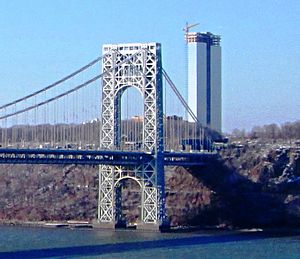
The George Washington Bridge is the tallest structure in Fort Lee, standing about 604 feet (184 meters) high from its base. The Palisades cliffs themselves are about 260 feet (79 meters) tall. Since the 1960s, many tall apartment buildings have been built along Palisade Avenue. This has made Fort Lee's population and housing density grow a lot. As of 2019, there were 10 buildings over 300 feet (91 meters) tall in Fort Lee.
| Rank | Name | Image | Height ft / m |
Floors | Year | Notes |
|---|---|---|---|---|---|---|
| 1= | The Modern 1 | 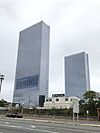 |
496 ft (151 m) | 47 | 2014 | |
| 1 | The Modern 2 | 496 ft (151 m) | 47 | 2018 | ||
| 3 | The Palisades | 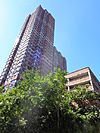 |
445 ft (136 m) | 41 | 2001 | |
| 4 | The Plaza |  |
347.2 ft (105.8 m) | 32 | 1975 | |
| 4 | The Colony | 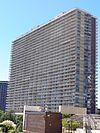 |
347.2 ft (105.8 m) | 32 | 1972 | |
| 6= | River Ridge | 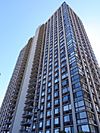 |
336.4 ft (102.5 m) | 31 | 1985 | |
| 6 | Century Towers | 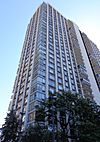 |
336.4 ft (102.5 m) | 31 | 1981 | |
| 8 | Horizon Towers North | 304 ft (93 m) | 28 | 1968 | ||
| 8 | Horizon Towers South | 304 ft (93 m) | 28 | 1968 | ||
| 9 | Mediterranean Towers West |  |
293 ft (89 m) | 27 | 1982 |
Famous People from Fort Lee
Many interesting people have lived in or are connected to Fort Lee. Here are a few:
- Mickey Appleman (born 1946), a professional poker player.
- Allan Arkush (born 1948), a film director and TV producer.
- Miri Ben-Ari (born 1978), an Israeli-American violinist.
- Barbara Bennett (1906–1959), a silent film actress.
- Constance Bennett (1904–1965), a stage and film actress.
- Joan Bennett (1910–1990), another stage and film actress.
- Mike Berniker (1935–2008), a record producer.
- Alessandra Biaggi (born 1986), a New York State Senator.
- Joyce Brothers (1927–2013), a psychologist and TV personality.
- Charlie Callas (1924–2011), a comedian and actor.
- Cam'ron (born 1976), a rapper.
- Jonathan Cheban (born 1974), a reality TV star.
- Nai-Ni Chen (1959–2021), a Taiwanese-American dancer.
- Jay Chiat (1931–2002), an advertising executive.
- Liz Claman (born 1963), a news anchor for Fox Business Network.
- Haskell Cohen (1914–2000), who created the NBA All-Star Game.
- Émile Cohl (1857–1938), a French animator.
- Celia Cruz (1925–2003), a Cuban-born salsa singer.
- Irv Docktor (1918–2008), an artist and illustrator.
- Morton Downey Jr. (1932–2001), a singer and TV host.
- Bill Evans (1929–1980), a jazz pianist and composer.
- Phil Foster (1913–1985), a comedian and actor.
- Buddy Hackett (1924–2003), a comedian and actor.
- Alan Hantman (born 1942), who was the Architect of the Capitol.
- Charles J. Hunt (1881–1976), a film editor and director.
- Jim Hunt, an ice hockey coach and team president.
- Arthur Imperatore Sr. (1925–2020), founder of NY Waterway.
- Jay-Z (born 1969), a famous rapper.
- Ron Johnson (1947–2018), a former NFL running back.
- Ali Khatami (born 1953), a former Iranian Presidential Chief of Staff.
- Randy Klein (born 1949), a musician and composer.
- Jack Langer (born 1948/49), a former basketball player.
- Lee Jeonghee (born 1963), a South Korean abacus master.
- Samm Levine (born 1982), an actor.
- Nathaniel Lubell (1916–2006), an Olympic fencer.
- Lynja (1956–2024), a chef known for her viral TikTok videos.
- Ted Manakas (born 1951), a former professional basketball player.
- Eddie Mannix (1891–1963), a film studio executive.
- Willard Marshall (1921–2000), a former MLB right fielder.
- Aline Brosh McKenna (born 1967), a screenwriter.
- Bill O'Reilly (born 1949), a TV host and commentator.
- John Orsino (1938–2016), a Major League Baseball catcher.
- Johnny Pacheco (1935–2021), a Dominican musician and bandleader.
- Christopher Porrino (born 1967), a lawyer who served as New Jersey Attorney General.
- George Price (1901–1995), a cartoonist for The New Yorker.
- Nia Reed (born 1996), a professional volleyball player.
- Richard Reines, a recording industry executive.
- Freddie Roman (1937–2022), a comedian.
- Joe Rosario (born 1959), an actor, writer, and director.
- Murray Sabrin (born 1946), a college professor and politician.
- Amy Scheer, a professional sports executive.
- August Semmendinger (1820–1885), a photographic inventor.
- Eva Shain (c. 1918–1999), one of the first female boxing judges.
- Jenn Sherman (born 1969), a fitness instructor for Peloton.
- Anton Sikharulidze (born 1976), an Olympic gold medal-winning figure skater.
- Phoebe Snow (1950–2011), a singer.
- Alfonso Soriano (born 1976), a former MLB outfielder.
- Darryl Strawberry (born 1962), a former MLB outfielder.
- Lyle Stuart (1922–2006), an independent book publisher.
- Justin Tuck (born 1983), a former NFL defensive end.
- June Valli (1928–1993), a singer and TV personality.
- James Van Fleet (1892–1992), a United States Army general.
- Chien-Ming Wang (born 1980), a baseball pitcher.
- Theodore Dwight Weld (1803–1895), and his wife Angelina Grimké (1805–1879), and her sister Sarah Moore Grimké (1792–1873), who were important figures in the anti-slavery movement.
- Jennifer Wu (born 1990), a table tennis player.
- Glen Zipper (born 1974), a writer and film producer.
See also
 In Spanish: Fort Lee (Nueva Jersey) para niños
In Spanish: Fort Lee (Nueva Jersey) para niños


